How To Install Your Ceiling Fan
Hunter Fan Installation Instructions
To install a Hunter ceiling fan, be sure you can do the following:
- Locate the ceiling joist or other suitable support in ceiling.
- Drill holes for and install wood screws.
- Identify and connect electrical wires.
- Lift 40 pounds.
If you need help installing the fan, your Hunter fan dealer can direct you to a licensed installer or electrician.
Tools You Will Need
- Electric drill with 9/64" bit
- Standard screwdriver
- Phillips-head screwdriver
- Wrench or pliers
- Ladder (height dependent upon installation site)
Checking Your Fan Parts
Carefully unpack your Hunter fan and check for damaged or missing parts. If any parts are missing or damaged please contact Hunter at 888-830-1326.
Understanding Installer's Choice®
Hunter's patented 3-position mounting system provides you maximum installation flexibility and ease. You can install your Hunter fan in one of three ways, depending on ceiling height and your preference: Low Profile, Standard, or Angle mounting. The steps in this guide include instructions for all three Installer's Choice mounting methods.
| Flush Mounting (Figure 1) fits close to the ceiling, for low ceilings less than 8 feet high. |  |
| Standard Mounting (Figure 2) hangs from the ceiling by a downrod (included), for ceilings 8 feet or higher. For ceilings higher than 8 feet, you can purchase Hunter extension Down Rods. All Hunter fans use sturdy 3/4" diameter pipe to assure stability and wobble-free performance. |  |
| Angle Mounting (Figure 3) hangs from a vaulted or angled ceiling. | 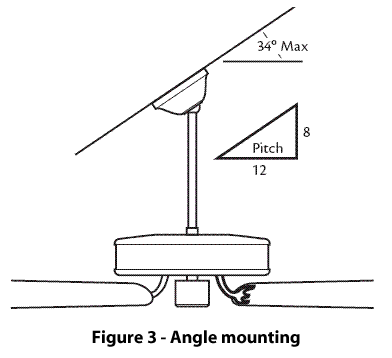 |
Preparing The Fan Site
These guidelines are designed to help you select the best location for your fan and to prepare the site prior to installing the fan. Proper ceiling fan location and attachment to the building structure are essential for safety, reliable operation, maximum efficiency, and energy savings.
Choosing The Fan Site
Within the room where you want to install the fan, choose a fan site where:
- No object can come in contact with the rotating fan blades during normal operation.
- The fan blades are at least 7 feet above the floor and the ceiling is at least 8 feet high.
- The fan blades have no obstructions to air flow, such as walls or posts, within 30 inches of the fan blade.
- The fan is directly below a joist or support brace that will hold the outlet box and the full weight of the fan.
- See Figure 4 for the minimum mounting distances.

Using an Existing Fan Site
If you are preparing a new fan site, go to the preparing a new fan site section.
If you plan to use an existing fan site, complete the following checklist for the support brace, ceiling hole, outlet box, and wiring. If you cannot check off every item, see the preparing a new fan site section for instructions on properly preparing the site for your new fan.
Fan Support System
- Fan must attach directly to building structure.
- Fan support system must hold full weight of fan and light kit.
Ceiling Hole
- Outlet box clearance hole directly below the joist or support brace.
Outlet Box
- UL-approved octagonal 4" x 1-1/2" outlet box (or as specified by the support brace manufacturer).
- Outlet box secured to joist or support brace by wood screws and washers through inner holes of outlet box.
- Outer holes of outlet box aligned with joist or support brace.
- Bottom of outlet box recessed a minimum of 1/16" into ceiling.
Wiring
- Electrical cable secured to outlet box by approved connector.
- Six inches of lead wires extend from outlet box.
See Figure 5 for an adequate existing fan site.

If your existing fan site is suitable, go to the installing the ceiling plate section and begin installing your new Hunter fan.
Preparing A New Fan Site
To prepare the fan site follow four steps:
- Cutting the Ceiling Hole
- Installing the Support Brace (if necessary)
- Installing the Outlet Box
- Preparing the Wiring
Cutting The Ceiling Hole
Locate the site for the hole directly below the joist or support brace that will hold the outlet box and fan. Cut a 4" diameter hole through the drywall or plaster of the ceiling as shown in Figure 6. You will use the hole to install the support brace and outlet box.

Installing The Support Brace
If there is a ceiling joist directly above the hole which will allow the outlet box to be recessed a minimum of 1/16" in the ceiling, go to installing the outlet box section.
If there is not an adequate ceiling joist available, do the following:
- Attach a 2" x 4" support brace between two joists. The support brace must allow the bottom of the outlet box to be recessed a minimum of 1/16" into the ceiling. See Figure 7.
- Check the support brace to ensure it will support the full weight of the fan and light kit.

Installing The Outlet Box
- Obtain a UL-approved octagonal 4" x 1-1/2" outlet box, plus two #8 x 1-1/2" wood screws and washers, available from any hardware store or electrical supply house.
- Orient the outlet box so that both the inner and outer holes in the box align with the joist or support brace. Drill pilot holes no larger than the minor diameter of the wood screws (5/64") through the inner holes of the outlet box.
- Attach the outlet box directly to the support brace or joist with two #8 x 1-1/2" wood screws and washers. The bottom of the outlet box must be recessed a minimum of 1/16" into the ceiling as shown in Figure 7.
Preparing The Wiring
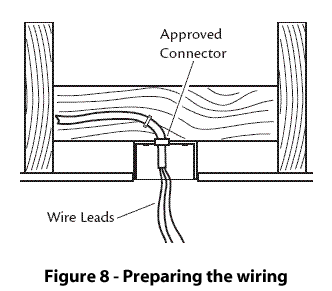
CAUTION: All wiring must be in accordance with national and local electrical codes and ANSI/NFPA 70. If you are unfamiliar with wiring, you should use a qualified electrician.
- Make sure the circuit breakers to the fan supply line leads and associated wall switch location are turned off. If you cannot lock the circuit breakers in the off position, securely fasten a prominent warning device, such as a tag, to the service panel.
- Thread the fan supply line through the outlet box so that the fan supply line extends at least 6" beyond the box as shown in Figure 8.
- Attach the fan supply line to the outlet box with an approved connector, available at any hardware store or electrical supply house. Refer to Figure 8.
- Make certain the wiring meets all national and local standards and ANSI/NFPA 70.
You have now successfully prepared your ceiling fan site. For instructions on how to install your ceiling fan, continue with the installing the ceiling plate section.
Installing The Ceiling Plate
- Drill two pilot holes into the wood support structure through the outermost holes on the outlet box. The pilot holes should be 9/64" in diameter.
- Thread the lead wires from the outlet box through the hole in the middle of the ceiling plate.
- Your fan comes with four neoprene noise isolators. Position the isolators between the ceiling plate and ceiling by inserting the raised areas on each isolator into the holes in the ceiling plate. Refer to Figure 9.

- Align the slotted holes (refer to Figure 10) in the ceiling plate with the pilot holes in the wood support structure. Note: The isolation pads should be flush against the ceiling.
- For Angled Ceilings: Be sure to orient the ceiling plate so that the arrows on the ceiling plate are pointing towards the ceiling peak. Refer to Figure 10.

- Place a flat washer on each of the two 3" screws and pass the screws through the slotted holes in the ceiling plate as shown in Figure 11.
- Tighten the screws into the 9/64" pilot holes; do not use lubricants on the screws. Do not overtighten.

Assembling The Fan For A Standard or Angled Ceiling
- Insert the downrod through the canopy and canopy trim ring as shown in Figure 12. Feed wires from the fan through the downrod.
- Screw the downrod into the fan assembly until tight. IMPORTANT! Tighten downrod set screw as shown in Figure 12.
- CAUTION: The downrod has a special coating on the threads. Do not remove this coating; the coating prevents the downrod from unscrewing. Once assembled, do not remove the downrod.
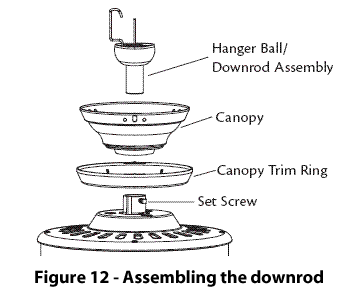
Continue to the hanging the fan section.
Assembling The Fan For A Low Ceiling
- Remove the screw on the hanger ball to disassemble it from the downrod as shown in Figure 13.
- Remove the hook from the assembly.
- Completely remove the set screw (identified in Figure 12) from the fan adapter.
- Put the set screw, previously removed, through the two black neoprene washers and the hook as shown in Figure 14. Hook must be installed in same orientation as shown in Figure 14.
- Reassemble the set screw to the adapter as shown in Figure 14. NOTE: The rubber washers should be tight enough to keep the hook standing straight up, but the set screw should not be completely tighten as to keep the hook from being able to swing.
- Place the canopy trim ring then the canopy over the adapter as shown in Figure 15.
- Place the low profile washer (lip up) into the canopy as shown in Figure 15 fitting the notch in the low profile washer over the adapter set screw and hook.
- Rotate the canopy until the arrow on the low profile washer aligns with the tab hole on the canopy as shown in Figure 15.
- Align the holes in the low profile washer with the holes in the adapter and assemble securely with the three #8-32 x 1" screws.



Hanging The Fan
Raise the fan and place the hook through the loop on the ceiling plate as shown in Figure 16. Use the note and arrow engraved in the ceiling plate to assist in determining the direction to assemble.

WARNING: Fan may fall if not assembled as directed in these installation instructions.
Wiring The Fan
Disconnect the power by turning off the circuit breakers to the outlet box and associated wall switch location.
You can use either one or two wall switches to control the fan and/or lights separately. Use connection 1, as described in Figure 17, to:
- control the light with a wall switch and the fan with a pull chain (one wall switch required),
- control the light with a pull chain and the fan with a wall switch (one wall switch required), or
- control the light with one wall switch and the fan with another (two wall switches required).
Use connection 2, as described in Figure 17, if there is no separate wall switch power wire for the light fixture.
- Connect the wires as shown in Figure 17. To connect the wires, twist the bare metal leads together. Place a wire nut over the intertwined length of wire and twist clockwise until tight as.
- CAUTION: Be sure no bare wire or wire strands are visible after making connections. All wiring must be in accordance with national and local electrical codes and ANSI/NFPA 70. If you are unfamiliar with wiring, you should use a qualified electrician.

Installing The Canopy
- Rotate the fan 180° clockwise from the initial position when hanging the fan. The arrows on the hanger ball and on the ceiling plate should be pointing in the same direction and should be pointing towards the tab hole on the canopy. Refer to Figure 18.
- For Flush Mounting: The arrows on the low profile washer and on the ceiling plate should be pointing in the same direction and should be pointing towards the tab hole on the canopy.
- Hook the tab hole over the tab on the ceiling plate as shown in Figure 19.
- Raise the canopy, be sure the holes in the canopy and the ceiling plate are aligned, and loosely assemble the canopy screws one at a time. When all three screws are assembled, securely tighten all three canopy screws. Refer to Figure 19.


Installing The Canopy Trim Ring
To easily install the canopy trim ring, locate the two tabs on the canopy trim ring. See Figure 20.
- Take both hands and push the canopy trim ring up to the top of the canopy. See Figure 20.
- The canopy trim ring will snap and lock into place on the canopy.

Removing The Canopy Trim Ring
- Locate the tab indicators, small bumps on top of tabs. Refer to Figure 21.
- To remove the canopy trim ring, press firmly on opposite sides of the ring towards the canopy as shown in Figure 21. The tabs will flex out releasing the trim ring from the canopy.
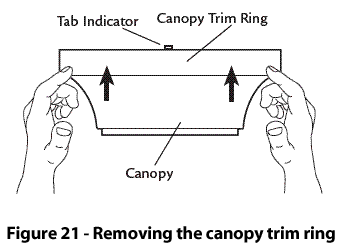
Assembling The Blades
Hunter fans use several styles of fan blade irons (brackets that hold the blade to the fan).
- Your fan may include blade grommets. If your fan has grommets, insert them by hand into the holes on the blades as shown in Figure 22.
- Attach each blade to blade iron using three blade assembly screws as shown in Figure 23.
- Some fans feature a decorative medallion as well as a blade iron. Insert the assembly screws into the blade iron, through the blade and into the medallion, with the blade sandwiched between the blade iron and medallion as shown in Figure 24.
- If you used grommets, the blades may appear slightly loose after screws are tightened. This is normal.
- Remove the blade mounting screws and rubber shipping bumpers from the motor.
- For each blade, insert one blade mounting screw through the blade iron as shown in Figure 25, and attach lightly to the fan. Insert the second blade mounting screw, then securely tighten both mounting screws.




Installing The Light Fixture
You can install with or without the light fixture. If you want to install without the light fixture, skip to the installing without the light fixture section.
WARNING: Use only the supplied light fixture for this fan model.
Attaching The Upper Switch Housing
- Partially install two #6-32 x 3/8" housing assembly screws into the switch housing mounting plate as shown in Figure 26.
- Feed the upper plug connector through the center opening of the upper switch housing. See Figure 26.
- Align the keyhole slots in the upper switch housing with the housing assembly screws installed previously.
- Turn the upper switch housing counterclockwise until the housing assembly screws are firmly situated in the narrow end of the keyhole slots as shown in Figure 27. Install the one remaining #6-32 x 3/8" housing assembly screw into the third hole in the upper switch housing. Tighten all three screws firmly.
- CAUTION: Make sure the upper switch housing is securely attached to the switch housing mounting plate. Failure to properly attach and tighten all three housing assembly screws could result in the switch housing and light fixture falling.


Attaching The Light Fixture
Refer to Figure 28.

- Remove the plug cap from the lower switch housing. Note: Do not discard the plug cap. You will need this if you remove the light fixture in the future.
- Remove top housing from the light fixture by loosening the three screws and turning counter clockwise.
- Locate the two wires in the lower switch housing labeled “Connect Light Here” or “For Light Use”. One will be white, the other black/white. Unscrew the wire nuts counterclockwise to expose the bare metal leads.
- Place these wires into the hole in the center of the top housing for the light kit. Slide the top housing over the two wires.
- Screw the fixture into the lower switch housing. Thread the lockwasher and nut provided over the wires. Making sure the light fixture mounting screw holes are aligned; hold the light fixture and tighten the nut on the inside of the lower switch housing. Insert and tighten the two #6-32 sems light fixture mounting screws. Refer to Figure 28.
- Locate the white wire and the black wire coming from the light fixture.
- Thread the two wires from the light fixture through the center hole in the lower switch housing.
- Connect the black wire from the light fixture to the black/white wire from the lower switch housing.
- Connect the white wire from the light fixture to the white wire from the lower switch housing.
- To fasten the wires, twist the two bare leads together. Place a wire nut over the intertwined length of wire and twist clockwise until tight.
- Install the light kit on the top housing so that the three screws are aligned with the mounting holes of the light kit. Insert and tighten the three housing screws.
Installing The Paper Shades
Refer to Figure 29.

- Light shades are installed on top of the candlestick containing the light socket. Press down securely on top of shade.
- Install three max 40 Watt standard candelabra base incandescent bulbs.
Attaching The Lower Switch Housing
- Connect the upper plug connector from the motor to the lower plug connector in the lower switch housing assembly. See Figure 30.
- NOTE: Both plug connectors are polarized and will only fit together one way. Make sure that both connectors are properly aligned before connecting them together. Incorrect connection could cause improper operation and damage to the product.
- Place the lower switch housing assembly over the upper switch housing. Align the side screw holes in the upper and lower switch housings. Attach the lower switch housing to the upper switch housing with three #6-32 x 3/8" housing assembly screws. See Figure 30.

Installing Without The Light Fixture
Your Hunter fan comes with a light fixture assembly. This feature gives you the option of installing the fan with or without the included light fixture.
If you decide to install the fan without the light fixture please complete the following instructions.
Attaching The Upper Switch Housing
- Partially install two #6-32 x 3/8" housing assembly screws into the switch housing mounting plate as shown in Figure 26.
- Feed the upper plug connector through the center opening of the upper switch housing. See Figure 26.
- Align the keyhole slots in the upper switch housing with the housing assembly screws installed previously.
- Turn the upper switch housing counterclockwise until the housing assembly screws are firmly situated in the narrow end of the keyhole slots as shown in Figure 27. Install the one remaining #6-32 x 3/8" housing assembly screw into the third hole in the upper switch housing. Tighten all three screws firmly.
- CAUTION: Make sure the upper switch housing is securely attached to the switch housing mounting plate. Failure to properly attach and tighten all three housing assembly screws could result in the switch housing and light fixture falling.
Installing The Lower Switch Housing
- Connect the upper plug connector from the motor to the lower plug connector in the lower switch housing assembly. See Figure 30.
- NOTE: Both plug connectors are polarized and will only fit together one way. Make sure that both connectors are properly aligned before connecting them together. Incorrect connection could cause improper operation and damage to the product.
- Place the lower switch housing assembly over the upper switch housing. Align the side screw holes in the upper and lower switch housings. Attach the lower switch housing to the upper switch housing with three #6-32 x 3/8" housing assembly screws. See Figure 30.
Operating Your Ceiling Fan
Turn on electrical power to the fan.
The fan pull chain controls power to the fan. The pull chain has four settings in sequence: High, Medium, Low and Off.
- Pull the chain slowly to change settings.
- Release slowly to prevent the chain from recoiling into the blades.
- The chain uses a breakaway connector that separates if the chain is jerked. If this happens, simply reinsert the chain into the connector.
The light pull chain controls power to the light. The pull chain has two settings: On and Off.
Ceiling fans work best by blowing air downward (counterclockwise blade rotation) in warm weather to cool the room with a direct breeze. In winter, having the fan draw air upward (clockwise blade rotation) will distribute the warmer air trapped at the ceiling around the room without causing a draft. Refer to Figure 31.
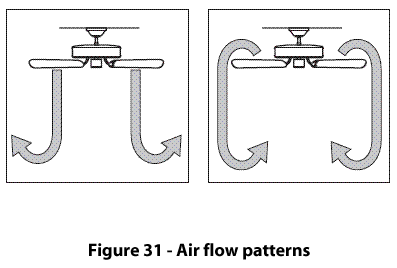
To change the direction of air flow, turn the fan off and let it come to a complete stop. Slide the reversing switch on the fan to the opposite position as shown in Figure 32. Restart fan.






























